
Cameroon, officially the Republic of Cameroon, is a country in Central Africa. It shares boundaries with Nigeria to the west and north, Chad to the northeast, the Central African Republic to the east, and Equatorial Guinea, Gabon and the Republic of the Congo to the south. Its coastline lies on the Bight of Biafra, part of the Gulf of Guinea and the Atlantic Ocean. Due to its strategic position at the crossroads between West Africa and Central Africa, it has been categorized as being in both camps. Its nearly 27 million people speak 250 native languages, in addition to the national tongues of English and French, or both.
At the crossroads of West Africa and Central Africa, the territory of what is now Cameroon has seen human habitation since some time in the Middle Paleolithic, likely no later than 130,000 years ago. The earliest discovered archaeological evidence of humans dates from around 30,000 years ago at Shum Laka. The Bamenda highlands in western Cameroon near the border with Nigeria are the most likely origin for the Bantu peoples, whose language and culture came to dominate most of central and southern Africa between 1000 BCE and 1000 CE.
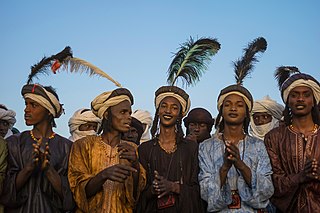
The Fula, Fulani, or Fulɓe people is an ethnic group in Sahara, Sahel and West Africa, widely dispersed across the region. Inhabiting many countries, they live mainly in West Africa and northern parts of Central Africa, South Sudan, Darfur, and regions near the Red Sea coast in Sudan. The approximate number of Fula people is unknown, due to clashing definitions regarding Fula ethnicity. Various estimates put the figure between 25 and 40 million people worldwide.
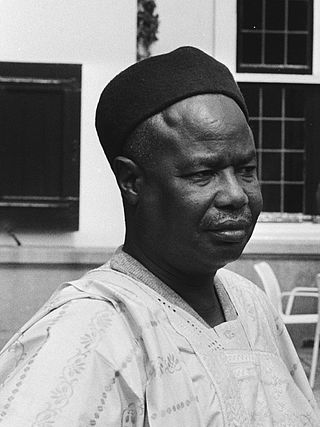
Ahmadou Babatoura Ahidjo was a Cameroonian politician who was the first president of Cameroon, holding the office from 1960 until 1982. Ahidjo played a major role in Cameroon's independence from France as well as reuniting the French and English-speaking parts of the country. During Ahidjo's time in office, he established a centralized political system. Ahidjo established a single-party state under the Cameroon National Union (CNU) in 1966. In 1972, Ahidjo abolished the federation in favor of a unitary state.
Articles related to Cameroon include:

The North Region makes up 66,090 km2 of the northern half of The Republic of Cameroon. Neighbouring territories include the Far North Region to the north, the Adamawa Region to the south, Nigeria to the west, Chad to the east, and Central African Republic to the southeast. The city of Garoua is both the political and industrial capital. Garoua is Cameroon's third largest port, despite the fact that the Bénoué River upon which it relies is only navigable for short periods of the year.

The Kirdi are the many cultures and ethnic groups who inhabit northwestern Cameroon and northeastern Nigeria.
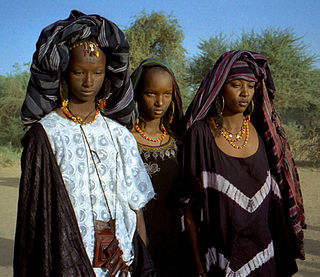
The Wodaabe is a name that is used to designate a subgroup of the Fula ethnic group who are traditionally nomadic found primarily in Niger and Chad. All Woodabe people should not be mistaken as Mbororo as these are two separate subgroups of the Fulani people. It is translated into English as "Cattle Fulani", and meaning "those who dwell in cattle camps". The Wodaabe culture is one of the 186 cultures of the standard cross-cultural sample used by anthropologists to compare cultural traits. A Wodaabe woman, Hindou Oumarou Ibrahim, was also chosen to represent civil society of the world on the signing of Paris Protocol on 22 April 2016.
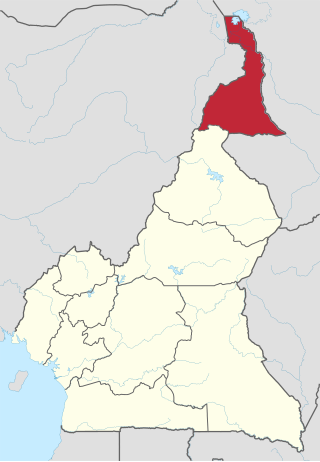
The Far North Region, also known as the Extreme North Region, is the northernmost and most populous constituent province of the Republic of Cameroon. It borders the North Region to the south, Chad to the east, and Nigeria to the west. The capital is Maroua.
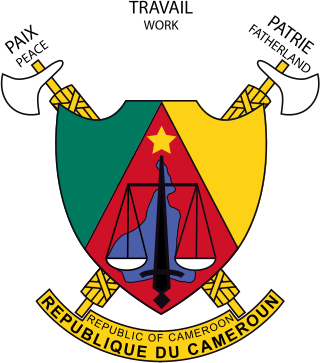
The Constitution of Cameroon is the supreme law of the Republic of Cameroon. Adopted in 1972, it is Cameroon's third constitution. The document consists of a preamble and 13 Parts, each divided into Articles. The Constitution outlines the rights guaranteed to Cameroonian citizens, the symbols and official institutions of the country, the structure and functions of government, the procedure by which the Constitution may be amended, and the process by which the provisions of the Constitution are to be implemented.

Dance in Cameroon is an integral part of the tradition, religion, and socialising of the country's people. Cameroon has more than 200 traditional dances, each associated with a different event or situation. Colonial authorities and Christian missionaries discouraged native dances as threats to security and pagan holdovers. However, after Cameroon's independence, the government recognised traditional dance as part of the nation's culture and made moves to preserve it.

The National Day of Cameroon, also known as Unitary State Day, is celebrated annually on 20 May. In a national referendum on 20 May 1972, Cameroonians voted for a unitary state as opposed to the existing federal state. The United Nations Trust Territory known as French Cameroun achieved independence from France on 1 January 1960, and British Southern Cameroons changed status from a Trusteeship under British administration to a federated state within Cameroon on 1 October 1961. The government chose 20 May as Cameroon's National Day to commemorate President Ahmadou Ahidjo's abolishment of the federal system of government in favor of a unitary country in 1972.

Christianity is the majority religion in Cameroon, with significant minorities of the adherents of Islam and traditional faiths.
Njomgang Isaac was a Cameroonian politician and administrator. He was the First black local Cameroonian Administrator appointed in Dschang Post Colonial Administration. He was born in 1931 at Tsep, Batoufam, West Region, Cameroon, and died in 2008.
The Cameroon War is the name of the independence struggle between Cameroon's nationalist movement and France. The movement was spearheaded by the Cameroonian Peoples Union (UPC). Even after independence, the rebellion continued, shaping contemporary politics. The war began with riots in 1955 and continued after Cameroon gained independence in 1960. Following independence, the first President of Cameroon, Ahmadou Ahidjo requested continued French military intervention to fight the UPC rebels. The UPC rebellion was largely crushed by the Cameroonian Armed Forces and French Army by 1964. This war is often forgotten because it occurred at the height of France's biggest colonial independence struggle, the Algerian War.

The Anglophone problem is a socio-political issue in the modern Republic of Cameroon, rooted in the country's German, British, and French colonial legacies. Anglophone (English-speaking) Cameroonians form a minority population of around 16 percent, mainly from the northwest and southwest regions that formerly constituted the Southern Cameroons, part of the former British Cameroon colonies. These Anglophone regions were formerly controlled by Britain as a mandate of the League of Nations, and then as a United Nations trust territory. During the Foumban Conference of 1961, territories with different colonial legacies were finally united into one state.

Germaine Habiba Ahidjo was a Cameroonian politician and nurse. She was the wife of the first president of Cameroon, Ahmadou Ahidjo. She was thus the First Lady of Cameroon from 1960 until 1982.
The Cameroon Presidential Guard, is a military protection unit of the Cameroon Armed Forces. Unlike the Republican Guard, which existed until early 1984 and was placed under the authority of the General Delegate for the Gendarmerie, the GP reports directly to the President.

The Ngarbuh massacre took place in northwestern Cameroon on 14 February 2020 during the Anglophone Crisis, and resulted in the murder of 21 civilians, including 13 children, by Cameroonian soldiers and armed Fulani militia.
René Philombé, pen name of Philippe Louis Ombedé, born in the city of Ngaoundere, was a Cameroonian writer, journalist, poet, novelist, and playwright who mostly wrote in French. He was one of the founders of the Association of Cameroonian Poets and Writers (APEC) of which he was the secretary for 20 years. He received the Mottart Prize from the Académie Française and the Fonlon-Nichols prize from the African Literature Association.
















